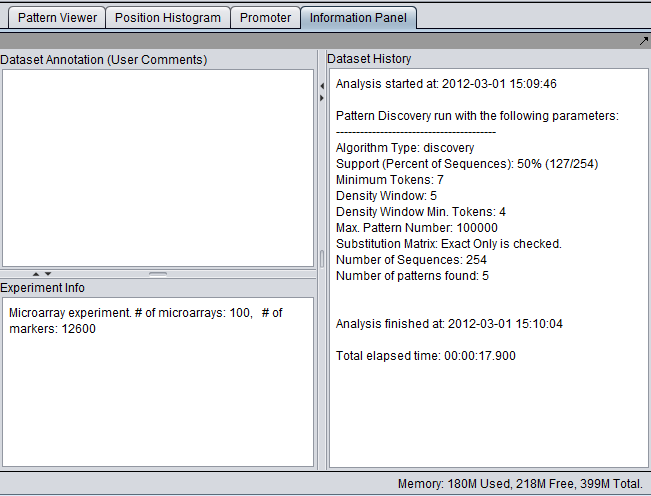Difference between revisions of "Information Panel"
m (moved Tutorial - Project Details to Project Details) |
|||
| (23 intermediate revisions by the same user not shown) | |||
| Line 1: | Line 1: | ||
{{TutorialsTopNav}} | {{TutorialsTopNav}} | ||
| − | |||
| − | |||
| − | |||
| − | |||
| − | |||
| + | ==Dataset History, Dataset Annotation and Experiment Information== | ||
| + | After any operation on a data node, such as analysis, normalization, or filtering, certain information is stored to that data node's Information Panel. The Information Panel is divided into three sub-windows. | ||
| − | |||
| − | |||
| + | [[Image:Information_Panel.png]] | ||
| − | |||
| − | |||
| + | Note - prior to geWorkbench v2.3.0, these three windows appeared as separate tabs in the geWorkbench Commands area. | ||
| + | ===Dataset History=== | ||
| + | The Dataset History window logs the parmater settings used for analysis, filtering and normalization. It also includes a listing of all arrays and markers used in an analysis. The dataset history is part of the [[Workspace]] and is persisted when the [[Workspace]] is saved. Data in the Dataset History pane is non-editable. | ||
| − | ===Dataset Annotation=== | + | ===Dataset Annotation (User Comments)=== |
| − | The Dataset Annotation component allows users to attach comments to Project Folders nodes. A user first selects the node of interest in the Project Folders tree and then enters the desired annotation (in the form of free text) in the Dataset Annotation pane. Annotations are stored along with their corresponding Project Folder nodes when the | + | The Dataset Annotation component allows users to attach comments to Project Folders nodes. A user first selects the node of interest in the Project Folders tree and then enters the desired annotation (in the form of free text) in the Dataset Annotation pane. Annotations are stored along with their corresponding Project Folder nodes when the [[Workspace]] is saved. |
| − | |||
| − | |||
| − | ===Experiment | + | ===Experiment Info=== |
| − | Experiment Info is a non-editable component | + | Experiment Info is a non-editable component intended for viewing information associated with a Microarray dataset. What constitutes "experiment information" varies depending on the source of the microarray dataset. E.g., for Affymetrix MAS5 files the file preamble (the part just before the data lines which provides various experiment execution parameters) becomes the experiment information. |
Latest revision as of 14:52, 22 April 2014
|
Home | Quick Start | Basics | Menu Bar | Preferences | Component Configuration Manager | Workspace | Information Panel | Local Data Files | File Formats | caArray | Array Sets | Marker Sets | Microarray Dataset Viewers | Filtering | Normalization | Tutorial Data | geWorkbench-web Tutorials |
Analysis Framework | ANOVA | ARACNe | BLAST | Cellular Networks KnowledgeBase | CeRNA/Hermes Query | Classification (KNN, WV) | Color Mosaic | Consensus Clustering | Cytoscape | Cupid | DeMAND | Expression Value Distribution | Fold-Change | Gene Ontology Term Analysis | Gene Ontology Viewer | GenomeSpace | genSpace | Grid Services | GSEA | Hierarchical Clustering | IDEA | Jmol | K-Means Clustering | LINCS Query | Marker Annotations | MarkUs | Master Regulator Analysis | (MRA-FET Method) | (MRA-MARINa Method) | MatrixREDUCE | MINDy | Pattern Discovery | PCA | Promoter Analysis | Pudge | SAM | Sequence Retriever | SkyBase | SkyLine | SOM | SVM | T-Test | Viper Analysis | Volcano Plot |
Contents
Dataset History, Dataset Annotation and Experiment Information
After any operation on a data node, such as analysis, normalization, or filtering, certain information is stored to that data node's Information Panel. The Information Panel is divided into three sub-windows.
Note - prior to geWorkbench v2.3.0, these three windows appeared as separate tabs in the geWorkbench Commands area.
Dataset History
The Dataset History window logs the parmater settings used for analysis, filtering and normalization. It also includes a listing of all arrays and markers used in an analysis. The dataset history is part of the Workspace and is persisted when the Workspace is saved. Data in the Dataset History pane is non-editable.
Dataset Annotation (User Comments)
The Dataset Annotation component allows users to attach comments to Project Folders nodes. A user first selects the node of interest in the Project Folders tree and then enters the desired annotation (in the form of free text) in the Dataset Annotation pane. Annotations are stored along with their corresponding Project Folder nodes when the Workspace is saved.
Experiment Info
Experiment Info is a non-editable component intended for viewing information associated with a Microarray dataset. What constitutes "experiment information" varies depending on the source of the microarray dataset. E.g., for Affymetrix MAS5 files the file preamble (the part just before the data lines which provides various experiment execution parameters) becomes the experiment information.

